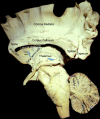A primer to vascular anatomy of the brain: an overview on anterior compartment
- PMID: 38630270
- PMCID: PMC11161539
- DOI: 10.1007/s00276-024-03359-0
A primer to vascular anatomy of the brain: an overview on anterior compartment
Abstract
Purpose: Knowledge of neurovascular anatomy is vital for neurosurgeons, neurologists, neuro-radiologists and anatomy students, amongst others, to fully comprehend the brain's anatomy with utmost depth. This paper aims to enhance the foundational knowledge of novice physicians in this area.
Method: A comprehensive literature review was carried out by searching the PubMed and Google Scholar databases using primary keywords related to brain vasculature, without date restrictions. The identified literature was meticulously examined and scrutinized. In the process of screening pertinent papers, further articles and book chapters were obtained through analysis and additional assessing of the reference lists. Additionally, four formalin-fixed, color latex-injected cadaveric specimens preserved in 70% ethanol solution were dissected under surgical microscope (Leica Microsystems Inc, 1700 Leider Ln, Buffalo Grove, IL 60089 USA). Using microneurosurgical as well as standard instruments, and a high-speed surgical drill (Stryker Instruments 1941 Stryker Way Portage, MI 49002 USA). Ulterior anatomical dissection was documented in microscopic images.
Results: Encephalic circulation functions as a complex network of intertwined vessels. The Internal Carotid Arteries (ICAs) and the Vertebral Arteries (VAs), form the anterior and posterior arterial circulations, respectively. This work provides a detailed exploration of the neurovascular anatomy of the anterior circulation and its key structures, such as the Anterior Cerebral Artery (ACA) and the Middle Cerebral Artery (MCA). Embryology is also briefly covered, offering insights into the early development of the vascular structures of the central nervous system. Cerebral venous system was detailed, highlighting the major veins and tributaries involved in the drainage of blood from the intracranial compartment, with a focus on the role of the Internal Jugular Veins (IJVs) as the primary, although not exclusive, deoxygenated blood outflow pathway.
Conclusion: This work serves as initial guide, providing essential knowledge on neurovascular anatomy, hoping to reduce the initial impact when tackling the subject, albeit the intricate vasculature of the brain will necessitate further efforts to be conquered, that being crucial for neurosurgical and neurology related practice and clinical decision-making.
Keywords: Anterior cerebral artery; Internal carotid artery; Middle cerebral artery; Neurovascular anatomy; Vascular compendium.
© 2024. The Author(s).
Conflict of interest statement
All authors certify that they have no affiliations with or involvement in any organization or entity with any financial interest (such as honoraria; educational grants; participation in speakers’ bureaus; membership, employment, consultancies, stock ownership, or other equity interest; and expert testimony or patent-licensing arrangements), or non-financial interest (such as personal or professional relationships, affiliations, knowledge or beliefs) in the subject matter or materials discussed in this manuscript.
Figures











Similar articles
-
Posterior vascular anatomy of the encephalon: a comprehensive review.Surg Radiol Anat. 2024 Jun;46(6):843-857. doi: 10.1007/s00276-024-03358-1. Epub 2024 Apr 23. Surg Radiol Anat. 2024. PMID: 38652250 Free PMC article. Review.
-
Microsurgical Neurovascular Anatomy of the Brain: The Anterior Circulation (Part I).Acta Biomed. 2021 Aug 26;92(S4):e2021412. doi: 10.23750/abm.v92iS4.12116. Acta Biomed. 2021. PMID: 34437363 Free PMC article.
-
Hypertensive Encephalopathy.2024 Feb 2. In: StatPearls [Internet]. Treasure Island (FL): StatPearls Publishing; 2024 Jan–. 2024 Feb 2. In: StatPearls [Internet]. Treasure Island (FL): StatPearls Publishing; 2024 Jan–. PMID: 32119386 Free Books & Documents.
-
Microsurgical Neurovascular Anatomy of the Brain: The Posterior Circulation (Part II).Acta Biomed. 2021 Aug 26;92(S4):e2021413. doi: 10.23750/abm.v92iS4.12119. Acta Biomed. 2021. PMID: 34437362 Free PMC article. Review.
-
[Association of three anatomical variants of the anterior cerebral circulation].Cir Cir. 2012 Jul-Aug;80(4):333-8. Cir Cir. 2012. PMID: 23374380 Spanish.
References
-
- Campero A, Ajler P (2019) Neuroanatomía quirúrgica: Ediciones Journal,
Publication types
MeSH terms
LinkOut - more resources
Full Text Sources

